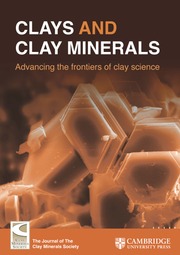No CrossRef data available.
Article contents
Influence of force field on clay–water contact angle determination using molecular dynamics
Published online by Cambridge University Press: 17 March 2025
Abstract
Clay minerals wettability is a key property for predicting water distribution and pollutant migration in natural or artificial materials. This study attempted to understand the difference in hydrophilicity due to the exchange of structural hydroxyl groups by fluorine atoms, observed in a number of clays. To this end, contact angles of water droplets on hydroxylated and fluorinated talcs were calculated from molecular simulations with two different force fields (one non-polarizable and one polarizable). In parallel, careful measurements of contact angles on a hydroxylated talc monocrystal were undertaken in order to assess the ability of the force fields to reproduce experiments. As expected, fluorinated talc was slightly more hydrophobic than hydroxylated talc for both force fields. Moreover, although the two force fields lead to fluid properties at the interface that were significantly different, the associated contact angles (and related works of adhesion) remained quite close to each other and to contact angles obtained on similar silica-type surfaces. These contact angles overestimated the experimental ones. This could be tentatively assigned to the presence of steps on monocrystal surfaces that could slightly increase the hydrophilicity of the surface, resulting in slightly lower contact angles. When analyzing more carefully the differences between both force fields, it appeared that the use of a polarizable force field resulted in a higher depletion of the fluid close to the surface. This could indicate less attraction between the fluid and the solid and a lesser constraint for the fluid. The combination of these two effects leads to a lower entropy loss and consequently to slightly higher work of adhesion.
Information
- Type
- Original Paper
- Information
- Copyright
- © The Author(s), 2025. Published by Cambridge University Press on behalf of The Clay Minerals Society


